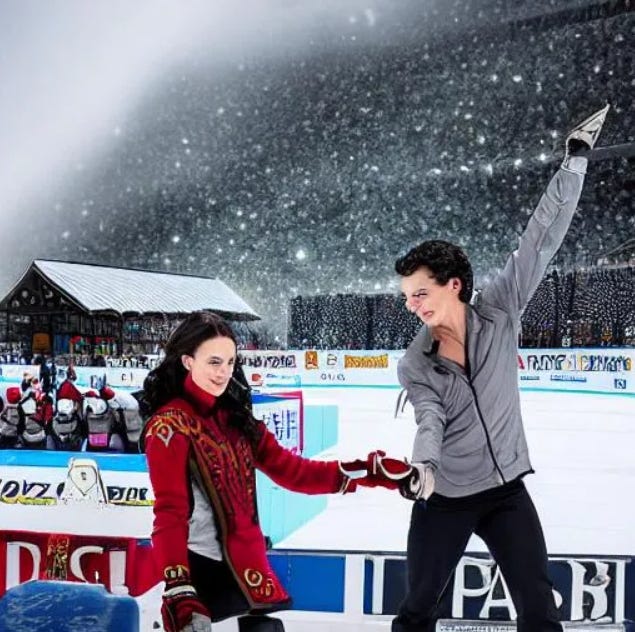Using artificial intelligence to tell the story of an iconic Canadian sporting moment
A fun experiment with an automation software.
While working on a story for True North (which will be published in the coming days), I discovered that Substack has introduced a tool to generate images using artificial intelligence (AI), and that sparked a fun idea.
The tool is easy to use — just type in what you want it to generate an image of, and what art style you want it to be in — a realistic photo, a cartoon, or a painting, to name a few of the options. Some of the designs are just lines and blobs of colour that don’t illustrate anything recognizable, but some are detailed depictions of what you asked it to generate.
You’ll see some of the image results below, as well as a story written entirely by AI program ChatGPT, one of the more popular programs of its kind. The command given was this: “Write an article about Tessa Virtue and Scott Moir winning the ice dance competition at the 2010 Winter Olympics.”
That’s it. Everything written after the horizontal line below was written entirely by the program almost instantly. I did proofread and fact check it, however, it to make sure all information in the story was accurate — and it was — as well as add in the images, but no other editing was done.
Enjoy this trip down memory lane! Stay tuned for more (human-written!) content coming very soon.
- Benedict Rhodes, Founder of True North
Tessa Virtue and Scott Moir Skate to Victory, Claim Olympic Gold in Ice Dance at 2010 Winter Games
Tessa Virtue and Scott Moir made history at the 2010 Winter Olympics in Vancouver when they became the first Canadian ice dance team to win Olympic gold. The duo's stunning performance captivated audiences and judges alike, earning them a score of 110.42 in the free dance and a total score of 221.57, both Olympic records at the time.
Virtue and Moir had been skating together since the ages of seven and nine, respectively. They quickly became one of Canada's most promising ice dance teams, earning their first Canadian national championship in 2008. They also won a silver medals at the 2008 World Figure Skating Championships, setting the stage for their Olympic debut.
The 2010 Winter Olympics marked the first time the event was held on Canadian soil since 1988, and Virtue and Moir were determined to make history. They entered the competition as one of the favorites, but they faced stiff competition from Americans Meryl Davis and Charlie White and Russians Oksana Domnina and Maxim Shabalin.
In the short dance, Virtue and Moir skated a flawless program to "Farrucas" by Pepe Romero, earning a score of 68.41 and taking a narrow lead over Davis and White. In the free dance, the Canadian duo took the ice to "Symphony No. 5" by Gustav Mahler, showcasing their incredible chemistry and technical prowess. They executed every element with precision and grace, earning a standing ovation from the crowd.

The judges were equally impressed, awarding Virtue and Moir a score of 110.42, the highest ever recorded in an Olympic ice dance competition at the time. Their combined score of 221.57 was also an Olympic record, securing their place in history as the first Canadian ice dance team to win Olympic gold.
Virtue and Moir's victory was a defining moment for Canadian figure skating, and it propelled them to superstardom. They went on to win more Canadian national championships and another Olympic gold medal in 2018. Their captivating performances, unmatched chemistry, and enduring friendship have made them one of the most beloved ice dance teams of all time.
In conclusion, Tessa Virtue and Scott Moir's victory at the 2010 Winter Olympics was a momentous occasion that will forever be etched in the history of Canadian figure skating. Their flawless performance and record-breaking score showcased their incredible talent and set the stage for their continued success on the ice. Virtue and Moir will always be remembered as one of the greatest ice dance teams of all time, and their legacy will continue to inspire future generations of skaters.
A bonus AI-generated image, of B.C. Place in Vancouver, where the opening and closing ceremonies took place at the 2010 Winter Olympics.
Thank you for reading this post on True North. To be the first person to read future posts, and listen to new podcast episodes, subscribe for free using the button below, or share the article with someone you know.





AI obviously hasn’t learned to make a human nose look real in an image...